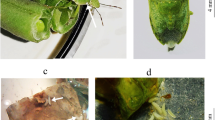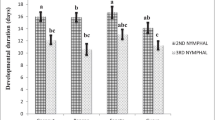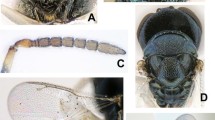Abstract
A new nematode, Tripius gyraloura n. sp., is described from the arundo gall midge, Lasioptera donacis Coutin (Diptera: Cecidomyiidae). This gall midge is being considered as a biological control agent for use in North America against the introduced giant reed Arundo donax (L.) (Poaceae: Cyperales). Thus the present study was initiated to investigate a nematode parasite that was unknown at the time studies with L. donacis were initiated. The new species has a rapid development in the fly host and the mature parasitic female nematodes evert their uterine cells in the hosts’ hemolymph. Because large numbers of nematodes sterilise the host, eradication of the parasite from laboratory colonies of the midge may be necessary before populations of the fly are released.
Similar content being viewed by others
Introduction
The Old World giant reed, Arundo donax (L.), native to the Mediterranean, was introduced into North America in the 16th Century (Tarin et al., 2013) and since then has become a noxious weed. Attempts have and are being made to find insects that feed on this invasive plant and may be useful in reducing its negative impacts (Seawright et al., 2009). The arundo gall midge, Lasioptera donacis Coutin (Diptera: Cecidomyiidae), is one of the insects under consideration. Studies were initiated at a quarantine facility in Texas to determine the potential of L. donacis imported from Europe as a biological control agent of giant reed. During these investigations, it was discovered that some of the larvae, pupae and adults of Lasioptera donacis sent from Europe were infected by a single species of parasitic nematode of the genus Tripius Chitwood, 1935 (Sphaerulariidae). The present work describes this nematode and discusses its biology in relation to the fly host.
Materials and methods
Stems of giant reed infested by Lasioptera donacis were collected in France, Italy and Greece, and shipped to Texas under permit where they were maintained at the USDA quarantine facility at Moore Air Base, Edinburg, TX. Larvae and pupae of Lasioptera donacis found in the leaf sheath, or adults emerging from these stems, were killed and fixed in 5% formalin or 95% ethanol. These specimens were forwarded to the senior author who dissected them for various stages of the nematode. Measurements were made on fixed nematodes that were processed to glycerine by the evaporation method. The following description is based on infective stage females and parasitic females removed from host material. Examination and photographs were made with a Nikon stereoscopic microscope SMZ-10-R at magnification of ×80 and a Nikon Optiphot microscope at magnification of ×1,000. Helicon Focus was used to stack photos for better depth of field. All measurements are in micrometres unless otherwise specified and are presented as the range followed by the mean in parentheses.
-
Order Tylenchida Thorne, 1949
-
Superfamily Sphaerularioidea Lubbock, 1861
-
Family Sphaerulariidae Lubbock, 1865
Tripius gyraloura n. sp.
Type-host: Arundo gall midge, Lasioptera donacis Coutin (Diptera: Cecidomyiidae).
Type-locality: Peraia, Greece.
Type-material: Free-living female (USDANL # T-661t) and paratype (parasitic female USDANL # T-6122p) deposited in the USDA Nematode Laboratory, Beltsville, Maryland. Paratypes are deposited in the first author’s collection.
Etymology: The specific epithet is from the Greek “gyros” (round) and the Greek “oura” (tail) in reference to the rounded tail tip on the parasitic juveniles, males and free-living females.
Description (Figs. 1–7)
General
Small nematodes with fine longitudinal and transverse cuticular striations. Stylet present, slightly knobbed in female; two subventral pharyngeal glands; anus conspicuous; all stages with rounded tails. Reproductive tract in female divided into a terminal ovary followed by oviduct, seminal vesicle or spermatheca containing sperm, quadricolumella and finally uterus, vagina and vulva (Fig. 4). Oviparous, with homogonic life-cycle (parasitic cycle only; no alternating free-living or plant feeding life-cycle generations). Bisexual; parasitic females evert uterine cells into host haemocoel during development.
Tripius gyraloura n. sp. 3, Infective stage female shortly after entering the body cavity of a larva of Lasioptera donacis; 4, Drawing of the female shown in Fig. 3. Abbreviations: A, anus; E, excretory pore; G, gut; Gd1, anterior gland duct; Gd2, posterior gland duct; G1, anterior subventral gland; G2, posterior subventral gland; N, nerve-ring; O, oviduct; Ov, ovary; Q, quadricolumella; S, seminal receptacle (spermatheca); St, stylet; U, uterus; V, vulva. Scale-bars: 3, 41 µm; 4, 26 µm
Free-living infective stage female (n = 10). Stylet well developed, length 8–15 (10); pharyngeal glands prominent; first subventral gland duct positioned immediately posterior to stylet base; second subventral gland duct positioned about 1.5 stylet lengths posterior to stylet base. Body length 297–360 (325); greatest body width 16–26 (20); distance from anterior extremity to nerve-ring 36–67 (50); distance from anterior extremity to excretory pore 50–88 (66); length of first subventral gland 133–160 (145); length of second subventral gland 147–166 (155); tail length 20–34 (28); % vulva 74–88 (82)%.
Free-living male (n = 6). Stylet very faint, lacking basal thickenings; pharyngeal glands greatly reduced; testis outstretched, spicules paired, slightly curved, faintly cephalated; gubernaculum short, bursa absent. Body length 415–428 (420); body width 10–18 (14); stylet length 7–10 (8); distance from anterior extremity to nerve-ring, 28–38 (35); distance from anterior extremity to excretory pore, 38–47 (40); length of spicules 6–10 (8); length of gubernaculum 3–4 (3), length of tail 30–43 (37); tail tip rounded.
Parasitic female (n = 8). Long, swollen, oviparous nematodes with cephalic and caudal region often narrowed. Stylet well developed. Uterine cells partly expelled through vulva into host haemocoel. Body length 0.6–2.0 (0.9) mm, greatest width 48–135 (58); % vulva 85–96 (89)%; eggs ellipsoidal, length, 70–76 × 22–29 (73 × 25). Gut cell boundaries difficult to decipher; gut probably syncytial.
Fourth stage parasitic juveniles (n = 10). Body length 290–430 (360), width 10–26 (17); enclosed in fourth stage cuticle.
Remarks
Previous authors have considered the portion of the uterus positioned posterior to the vulva as a post-uterine sac. Here it is actually part of the normal uterus that is extended posteriorly and not a specialised structure. The quadricolumella is that portion of the oviduct that secretes the egg shell. While there is an obvious anus, the gut is not connected to the mouth and appears to be a food storage organ, providing the body with nutrients absorbed from the host via the cuticle. The uterine cells are never completely expelled through the vulva as they are in Tripius gibbosus (Leuckart, 1887) (see Leuckart, 1887).
Currently there are two described species in the genus Tripius. Tripius gyraloura n. sp. differs from T. gibbosus in possessing a stylet with faint basal thickenings and a pair of subventral pharyngeal glands with duct openings located directly or slightly behind the stylet base. The stylet of the free-living infective stage female of T. gibbosus lacks basal thickenings and the single pharyngeal gland duct opening is positioned posterior to the excretory pore. In addition, all stages of T. gyraloura have a rounded tail tip, while those of T. gibbosus have a pointed tail tip. Also, the infective stage female of T. gyraloura has a much shorter tail (28 vs 75 µm in T. gibbosus) and a longer % vulva (mean 82 vs 70% in T. gibbosus) (see Leuckart, 1887).
The infective female of Tripius sciarae (Bovien, 1944) has a stylet with a tripartite base, whereas the stylet base of T. gyraloura n. sp. is slightly thickened but not tripartite. The ventral gland openings of T. sciarae are two stylet lengths posterior to the stylet base whereas in T. gyraloura they open immediately and 1.5 stylet lengths posterior to the stylet. In addition the ducts of the two subventral glands are separate in T. gyraloura but are opposite in T. sciarae. Free-living stages of T. gyraloura have a rounded tail tip, while those of T. scariae have a pointed tail tip. Also, the infective stage female of T. gyraloura has a much shorter tail, the proportion of tail length to body length is 1/11 while it is 1/5 in T. sciarae and the position of the vulva is 74–88% in T. gyraloura while this value is 65–72% in T. sciarae (see Bovien, 1944; Poinar, 1965). The latter species is a parasite of sciarid flies while T. gibbosus is a parasite of gall midges and has not been recovered since its discovery in 1887 (Poinar, 1975).
The only other nematode parasite infecting a member of the family Cecidomyiidae is the fossil Tertiary mermithid Heydenius cecidomyae Poinar, 2011 entombed in 40–50 million year-old amber from the Baltic Region (Poinar, 2011). Mermithid nematodes have no resemblance to the species of Tripius presented here.
Life-cycle and effect on host
After fertilisation in the environment, the males die and the females utilise the secretions in their subventral pharyngeal glands to penetrate the body wall of host larvae. This method of entrance was shown to occur in the infective females of the sciarid parasite T. sciarae in England (Poinar & Doncaster, 1965). Most juvenile development occurs in the pupal and adult stages of the flies and infected adult hosts are often packed with spent females and fourth stage juveniles (Fig. 1). We suggest that the mature juveniles are initially expelled out of the host’s ovipositor but also exit the fly when it dies, as was noted with T. scariae (see Poinar & Doncaster, 1965). Many infected adult flies have their body cavities filled with nematodes and heavily parasitised female hosts show no or little sign of egg development. Thus the nematode can be considered an important natural enemy of Lasioptera donacis. Similar host effects were noted with T. gibbosus (see Leuckart, 1887) and T. sciarae (see Bovien, 1944; Poinar 1965).
Discussion
The present study establishes a third species in the genus Tripius. Two of these (T. gibbosus and Tripius gyraloura n. sp.) infect flies of the family Cecidomyiidae while T. sciarae is restricted to sciarid flies. While the latter species is fairly common, T. gibbosus is not known except from its original description by Leuckart in 1887.
There is presumably a complex of closely related Tripius species and strains that parasitise cecidomyiids globally even though Tripius gyraloura n. sp. is only the second species reported from gall midges. While in the same family (Cecidomyiidae) and subfamily (Cecidomyiinae), the two gall midge hosts of T. gyraloura n. sp. and T. gibbosus, namely Lasioptera donacis Coutin and Cecidomyia pini DeGeer respectively, are only distantly related. Lasioptera is in the supertribe Lasiopteridi while Cecidomyia is in the supertribe Cecidomyiidi.
The variability in their body size and shape in the parasitic female of Tripius gyraloura is quite striking. The body can be quite narrow and elongate (Figs. 5, 6) as well as robust (Fig. 7). It is likely that body shape is dependent on the amount of food available when the nematode first enters the haemocoel of its host and initiates growth. If only one or several infective stages enter, there is probably a sudden growth in length, whereas if several nematodes enter at approximately the same time, body size is reduced.
Protrusion of uterine cells through the vulva occurs in several other nematode species besides members of the genus Tripius such as the bumblebee parasite, Sphaerularia bombi (Dufour, 1837) (see Leuckart, 1887; Poinar & van der Laan, 1972) and members of the tylenchid genus Sphaerulariopsis Wachek, 1955 that parasitise bark beetles (Coleoptera: Scolytidae) and anobiid beetles (Coleoptera: Anobiidae) (Poinar, 1975).
References
Bovien, P. (1944). Proatractonema sciarae n. g., n. sp., a parasitic nematode from the body cavity of a dipterous larva. Videnskabelige Meddelelser Dansk Naturhistorisk Forening, 108, 1–14.
Leuckart, R. (1887). Neue Beiträge zur Kenntnis des Baues und der Lebensgeschichte der Nematoden. Abhandlungen der Mathematisch-Physischen Klasse der Sächssischen der Gesellschaft der Wissenschaften, 13, 565–704.
Poinar, G. O, Jr. (1965). The bionomics and parasitic development of Tripus sciarae (Bovien) (Sphaerulariidae: Aphelenchoidea) a nematode parasite of sciarid flies (Sciaridae: Diptera). Parasitology, 55, 559–569.
Poinar, Jr, G. O. (1975). Entomogenous nematodes. A manual and host lost of insect-nematode associations. Leiden: E.J. Brill, 317 pp.
Poinar, G. O, Jr. (2011). The evolutionary history of nematodes Leiden: E.J. Brill, 429 pp.
Poinar, G. O, Jr, & Doncaster, C. C. (1965). The penetration of Tripius sciarae (Bovien) (Sphaerulariidae: Aphelenchoidea) into its insect host, Bradysia paupera Tuom. (Mycetophilidae: Diptera). Nematologica, 11, 73–78.
Poinar, G. O, Jr, & van der Laan, P. A. (1972). Morphology and life history of Sphaerularia bombi (Dufour) (Nematodea). Nematologica, 18, 239–252.
Seawright, E. K., Rister, M. E., Lacewell, R. D., McCorkle, D. A., Sturdivant, A. W., Yang, C., & Goolsby, A. (2009). Economic implications for the biological control of Arundo donax: Rio Grande Basin. Southwestern Entomologist, 34, 377–394.
Tarin, D., Manhart, J., Pepper, A., Goolsby, J., Moran, P., Contreras-Arquieta, B., & Kirk, A. (2013). Microsatellite markers indicate multiple origins of Arundo donax L. in North America. Invasive Plant Science and Management, 6, 328–338.
Acknowledgements
The authors thank Ray Gagne for providing systematic information on the two gall midge species parasitised by Tripius nematodes. Financial support for this research was provided by the U.S. Department of Homeland Security. Specimens of Lasioptera donacis and Arundo donax were imported under permit from USDA-APHIS-PPQ which also provided access to the quarantine facility in Texas. Massimo Cristofaro, Javid Kashefi and Alan Kirk collected and shipped the material from Europe used in these studies. Crystal Salinas and Selina Ramirez provided assistance with colony maintenance and specimen collections. We are especially grateful to John Goolsby for logistical support. Mention of trade names or commercial products in this article is solely for the purpose of providing information and does not imply recommendation or endorsement by the USDA, an equal opportunity employer.
Author information
Authors and Affiliations
Corresponding author
Rights and permissions
Open Access This article is distributed under the terms of the Creative Commons Attribution License which permits any use, distribution, and reproduction in any medium, provided the original author(s) and the source are credited.
About this article
Cite this article
Poinar, G., Thomas, D.B. Tripius gyraloura n. sp. (Aphelenchoidea: Sphaerulariidae) parasitic in the gall midge Lasioptera donacis Coutin (Diptera: Cecidomyiidae). Syst Parasitol 89, 247–252 (2014). https://doi.org/10.1007/s11230-014-9524-1
Received:
Accepted:
Published:
Issue Date:
DOI: https://doi.org/10.1007/s11230-014-9524-1








